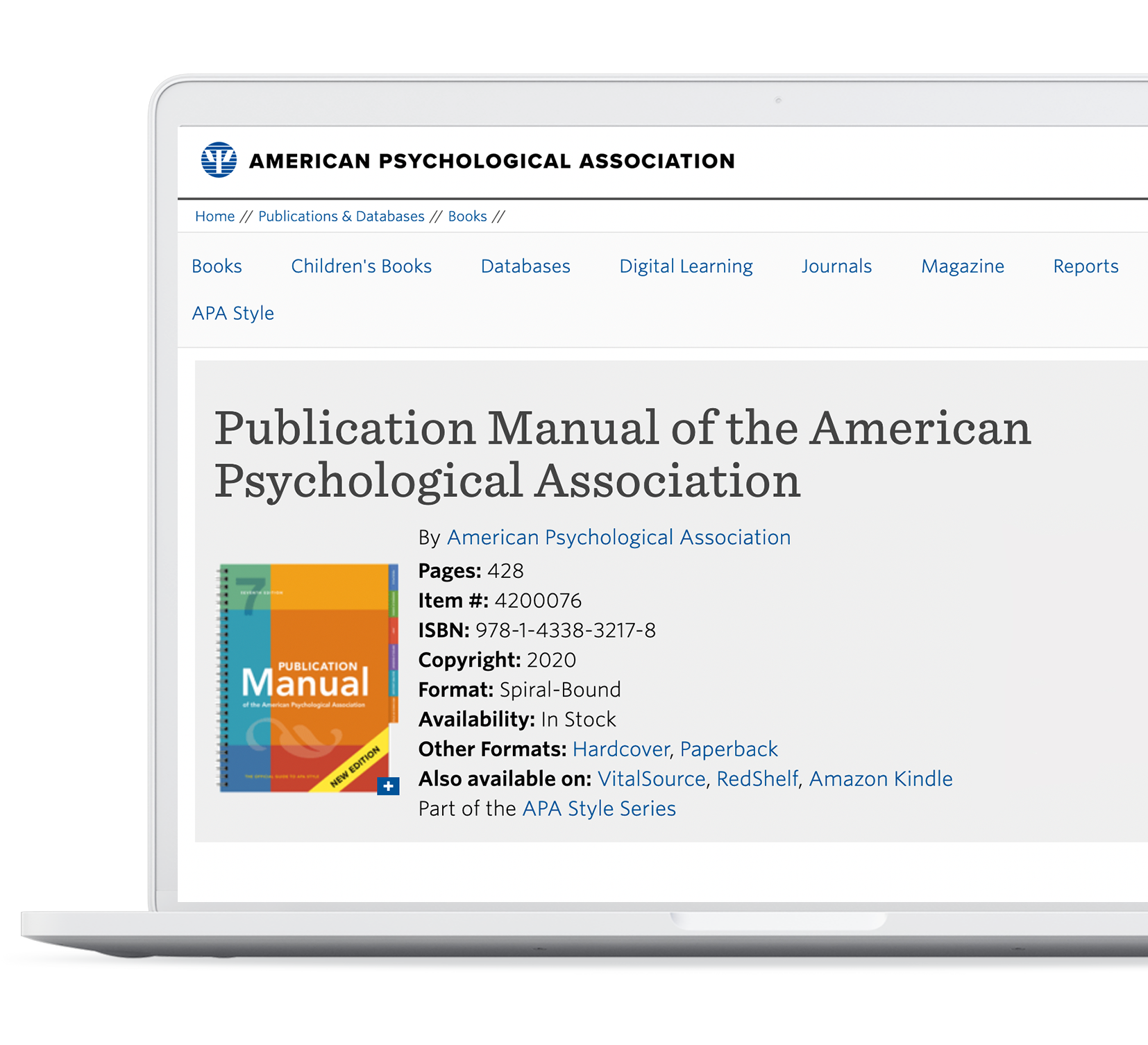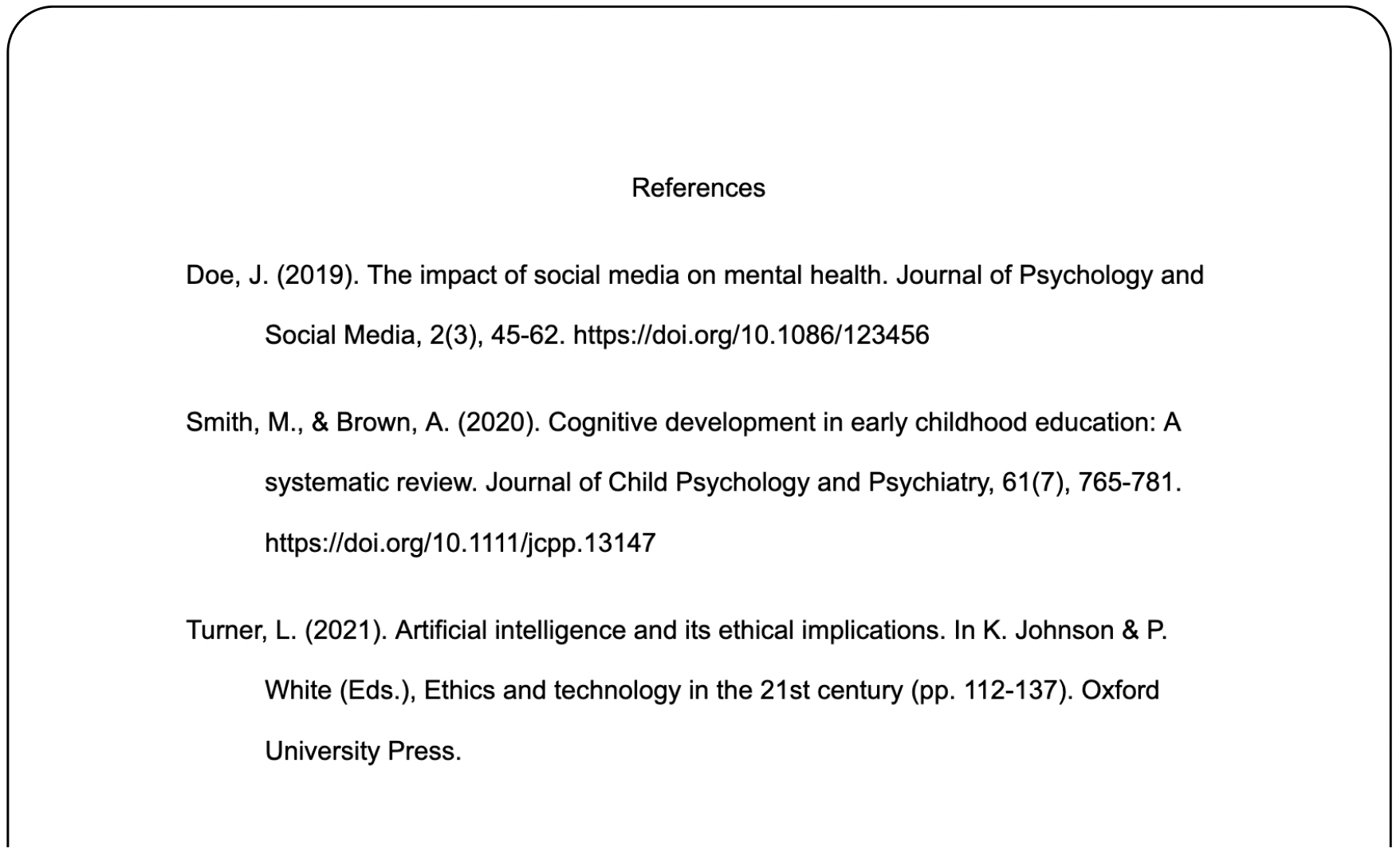Bibcitation is a free citation generator that creates bibliographies, references and works cited. Automatically generate MLA, APA, Chicago and other citations and create an accurate bibliography in one click.
No citations yet
Our Complete Guide to Citing in APA 7 Format

In this comprehensive guide, we will explore how to write an academic paper in APA, including formatting in-text citations and reference lists.
Our detailed examples will help you seamlessly incorporate accurate citations into your work, ensuring you produce high-quality academic content. Mastering APA citations will not only improve your writing but also boost your credibility as a researcher.
Let's dive into the world of APA citations!






Discover More Bibcitation Guides
APA Format Overview
The American Psychological Association format is a widely-accepted citation style, particularly in the social sciences. It follows a set of rules for formatting in-text citations and reference lists to ensure consistency and clarity in academic writing. By adhering to these guidelines, you can enhance the readability of your work and make it easier for others to understand and reference your research.
APA citations have two main components: in-text citations and entries in the reference list.
In-text citations are brief notations within the body of your paper that indicate the source of your information.
The reference list is a comprehensive list of all sources cited in your work, listed in alphabetical order. This guide will help you understand and create both types of these citations with ease.
Create APA In-text Citations
In-text citations are used to acknowledge the sources of your information within the body of your paper. These citations typically include the author's last name and the publication year, enclosed in parentheses. For in-text citations, APA uses the author-date system.
If you are quoting directly from a source, you must also include the page number(s). For example: (Downey, 2020, p. 42).
When paraphrasing general information from a source, you only need to include the author's last name and publication year. For example: (Andrews, 2020).
If you are citing multiple sources in a single parenthetical citation, separate them with a semicolon, like so: (Cyrus, 2020, p. 9; Swift, 2019, p. 395).
For sources with multiple authors, follow these guidelines:
- Two authors: Include both authors' last names, separated by an ampersand (&). Example: (Wharton & Simmons, 2023).
- Three or more authors: Include the first author's last name followed by "et al." Example: (Trump et al., 2020).
Citing a source with no publication date? Use "n.d." instead of the year: (Mau, n.d.).
If you're citing multiple sources with the same author and publication year, add a lowercase letter (a, b, c, etc.) after the year to distinguish them: (Johnson, 2019a) and (Johnson, 2019b).
Format Your APA Reference List
Formatting a reference list in APA requires attention to detail and adherence to specific guidelines. By following these steps, you can ensure that your reference list is accurate, consistent, and meets APA style requirements.
Here are the key steps you need to take to format a reference list in APA:
- Start a new page: Begin your reference list on a new page after the body of your paper. The page should be titled "References" and should be centered at the top of the page. The reference list should be double-spaced, with a hanging indent for each entry.
- List your sources in alphabetical order: Your reference list should be organized in alphabetical order by the last name of the first author of each source. If a source does not have an author, alphabetize it by the title.
- Use hanging indentations: Each reference should be formatted with a hanging indentation. This means that the first line of each reference should be flush with the left margin, while the second and subsequent lines should be indented.
- Include all necessary information: Each reference should include all the necessary information required by APA style. This typically includes the author's name, publication date, title, and publication information such as the journal or book title, publisher, and page numbers.
- Follow the appropriate format for each source type: Different types of sources may require slightly different formatting in APA style. For example, books, journal articles, and websites may each have slightly different citation requirements.
- Check for accuracy: Be sure to check each reference for accuracy, including spelling and punctuation, as well as proper capitalization and italics.

Adhering to APA guidelines reflects a commitment to scholarly standards. Therefore, correctly formatted reference lists ensure that the writer avoids plagiarism, by giving credit to the original sources of information used in their work.
Cite Books in APA
To cite a book in your reference list, follow this format:
For example:
For edited books, include the editor's initials and last name, followed by "(Ed.)" or "(Eds.)" for multiple editors.
Citing a book with an editor as the author:
In cases where the book is part of a series or multi-volume set, include the volume number in parentheses after the title.
Common exceptions:
When referencing an ebook, it's crucial to provide the DOI or the URL if the DOI is unavailable. If your book is translated, remember to include the translator's initials and last name in addition to the original author's information. Additionally, if you're citing a specific chapter or section within a book, mention the page range where the cited information can be found. Later, we will cover these examples in detail.
Cite Journal Articles in APA
To cite a journal article in your reference list, follow this format:
For example:
For the journal articles that you accessed online, from JSTOR or a different online database, make sure to include the DOI or the URL if the DOI is unavailable.
Example:
If the article has two authors, the citation should include both names, separated by an ampersand (&).
Citing an article with two authors:
If the article has three or more authors, only the first author's name should be listed followed by "et al."
Citing an article with three and more authors:
In some cases, the journal article may not have an author. In this situation, the title of the article is used in place of the author's name.
Citing a journal article without an author:
Cite Websites in APA
Citing a webpage in your APA reference list? Use the following format:
For example:
However, quite often web pages don't have an identified author. In this situation, the title of the article is used in place of the author's name.
Citing a website without an author:
When citing a website with an organization as the author, you can use the organization's name as both the author and the website name if they are the same.
Citing a website published by an organization:
In cases where both the author and publication date are unavailable, begin with the webpage title, followed by "n.d." for "no date," the site name, and the URL.
For webpages that are part of a larger work, such as online articles or blog posts, use the specific webpage title, not the site name, in italics.
Remember to adjust the citation format accordingly to accommodate these exceptions and maintain the integrity of your references.
Cite Book Chapters in APA
Citing a book chapter in APA format requires you to include the chapter author and the book editor(s). The format is:
For example:
If the book has multiple authors, the citation should include the names of all the authors separated by commas, the year of publication, the chapter title, the editor's name, the book title, and the page numbers of the chapter.
Citing a book with multiple authors:
If the book chapter is from an edited book with no authors listed, the citation should include the chapter title, the editor's name, the book title, and the page numbers of the chapter.
Example:
Exceptions to these guidelines can arise if the book chapter is part of a larger work, such as an encyclopedia or handbook. In these cases, the citation should include the title of the larger work in italics followed by the page numbers of the chapter.
Citing a chapter from a collection of works:
Cite Ebooks in APA
Citing an ebook in APA format follows the same guidelines to citing a printed book, with the exception of adding a book DOI or URL. The format for citing an ebook is:
For example:
If the ebook has a DOI (Digital Object Identifier), the citation should include it at the end of the reference.
Example:
Exceptions to these guidelines can arise if the ebook is from a database or if it is a chapter within an edited ebook. In these cases, additional information may be required in the citation, such as the name of the database or the editor of the ebook.
It is important to consult the APA manual or a reliable online resource for guidance on citing these types of sources.
Cite Translated Books in APA
When citing a source that has been translated, include both the original author and the translator in the reference list entry:
For example:
Cite Magazine Articles in APA
When citing a magazine article in your APA reference list, use the following format:
For example:
If the magazine article is found online, you should also provide the URL or DOI at the end of the citation.
Example:
Cite Newspaper Articles in APA
For newspaper articles, the APA citation format is similar to magazine articles:
For example:
If the article is found online, include the URL or the DOI (Digital Object Identifier) if available, but do not include the page numbers.
If the newspaper article has no page numbers, you can use the section name or paragraph number instead. For an electronic newspaper, as seen in the example above, you can omit the page number of paragraph altogether.
Cite Conference Papers in APA
To cite a conference paper in your APA reference list, use the following format:
For example:
However, the specific details of the citation may change depending on the source and accessibility of the conference paper.
If the proceedings are published in a book, the citation format will also include the book title and publisher, as well as a DOI or a URL, if available.
Citing a conference paper published in a book:
When citing a paper presented at a conference but not published in the proceedings, you can format the citation as follows:
Example:
In the case of abstracts retrieved from a database, include the name of the database and accession number, if available:
Cite Audio & Visual Media in APA
For audiovisual materials like films, television series, and YouTube videos, include the contributor(s) most relevant to your source, such as the director, or if not available, then producer, or writer. The format is:
For example:
However, there are some exceptions to this format. If the audio or video material is retrieved online, the citation should include a URL or DOI.
For example:
When citing a material from a larger work, such as a television series or album, the citation should include the specific episode or track information, as well as the title of the larger work.
Citing a TV series episode:
Cite Podcasts in APA
To cite a podcast episode in APA format, use the following citation structure:
For example:
If the podcast is part of a larger series, the citation should include the title of the podcast series or network. Or, if the podcast is hosted by a group or organization, the host name can be included after the episode title, separated by a comma.
Additionally, if the podcast episode features a guest or interviewee, their name should also be included in the citation.
By following these guidelines and paying attention to specific requirements for different scenarios, you can accurately cite a podcast in APA format.
Cite Social Media Posts in APA
For social media posts, use the following format in your APA reference list:
Citing a Twitter post:
Citing an Instagram post:
Citing a Facebook post:
However, there are certain exceptions when it comes to citing social media posts in APA format. These exceptions mainly involve the type of content being cited and the platform on which the content appears. You can learn more about citing various social media posts on the APA Style website.
Cite Images & Artworks in APA
To cite an online image or artwork in your APA reference list, the format is:
For example:
However, not all artwork citations are created equal. For instance, in such cases when information about the creator, date, or title is not available, you should provide as much information as possible and use descriptive placeholders.
If the creator's name is unknown, use "Anonymous" or a description of the creator's role (e.g., "Photographer" or "Artist").
For an unknown date, use "n.d." (no date) in place of the year. If the title is not provided or cannot be determined, create a brief descriptive title in square brackets.
Citing an artwork without an author, date or title:
Additionally, when citing an artwork from a museum or other physical location, include the name and location of the institution or collection housing the artwork.
Citing an artwork viewed at a museum:
Cite Theses & Dissertations in APA
When using a thesis or dissertation in your APA citation list, use the following format:
For example:
Cite State Documents in APA
For government documents, include the name of the government, the department or agency, and the title of the document in your APA reference list entry:
Citing a government document:
If the document has a specific author, list their last name, followed by their initials, and then the agency in parentheses.
Cite Databases & Data Sets in APA
When citing datasets or statistical data, include the author, publication year, title of the dataset, version, publisher, and the DOI or URL in your APA reference list entry:
For example:
Note that when citing a specific article, book, or other work retrieved from a database, you should generally cite the original work, not the database itself.
Cite Mobile Applications in APA
Citing mobile applications in APA format requires the author, the app's publication year, the app's title, the version, and the platform in your reference list entry:
For example:
Don't forget to conclude the citation with the app's URL or the name of the platform where the app can be downloaded (e.g., App Store, Google Play Store)!
Cite Classical Works in APA
When citing classical works, such as the Bible or ancient Greek and Roman texts, use the specific edition or translation you used and include the book, chapter, and verse numbers in your in-text citation:
(Holy Bible, King James Version, 1 Cor. 13:4–7)
Previously, APA Style guidelines treated classical and ancient works differently than other types of sources. However, in the latest edition of the APA style manual, the citation for such sources has been updated to follow the format of a book citation. In the reference list, it is now essential to provide the edition or translation information for these works.
For example:
N.B. When referencing classical works, the original publication year is often unknown or irrelevant; instead, provide the year of the translation or version you are using in parentheses, followed by a period.
Cite Court Cases in APA
For legal materials, such as court cases, laws, or statutes, include the title of the case, law or statute, the publication year, the volume and page numbers, and the URL in your APA reference list entry:
For example:
When citing court cases in-text, use the case name in italics and the year of the decision:
(Brown v. Board of Education, 1954)
Cite Online Lectures & TED Talks in APA
When citing online lectures, webinars, or TED Talks, include the speaker, the date, the title of the talk, and the URL in your APA reference list entry:
For example:
Cite Course Materials & Lectures in APA
For course materials or lecture notes, include the author (if available), the publication year, the title of the material or lecture, the course code, and the URL or the location where the material was accessed in your APA reference list entry:
For example:
Secondary Citations & Personal Communications
When citing a source that you have not read but was cited in a source you have read (secondary citation), mention the original source in your text and include the secondary source in your reference list. Use the phrase "as cited in":
Andersen (2009, as cited in Johnson, 2021) argues that...
In the reference list:
Citing personal communications, such as emails, interviews, or private messages, requires a different approach in APA format. These sources are not included in the reference list, as they are not recoverable by your readers.
Instead, simply cite them in the text using the format:
(A. Tisdale, personal communication, Month Day, Year).
In-text citation example for personal communications:
According to S. Johnson (personal communication, April 18, 2023), the project will be completed by the end of this month.
APA Style: Final Notes
As you can see, the APA citation format provides a consistent and clear method for citing various types of sources in your research. By mastering the APA citation style, you will not only make your work more professional but also help your readers easily locate the sources you have used.
We hope this comprehensive guide on APA citation style has provided you with a solid foundation for citing sources in your research. Remember that Bibcitation is here to help you with all your citation needs, offering accurate and easy-to-use citation tools.